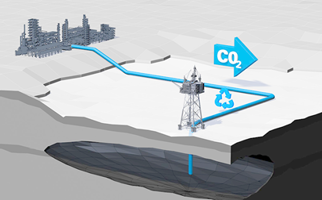
Over the past year, the Oil and Gas Authority (OGA) has started significant work on how we can support the energy transition alongside the core role of maximising economic recovery of UK oil and gas.
This has included publishing a flaring and venting policy and awarding our first CCS carbon dioxide (CO2) appraisal and storage licence. The OGA will publish a policy position on its role in the energy transition in the spring, and an Enhanced Oil Recovery (EOR) strategy, which will cover carbon dioxide EOR, in the autumn.
The OGA’s role in the energy transition has taken a further step, with the commencement of a new project to explore the potential for a more integrated offshore energy sector; including innovative closer links between oil and gas production and offshore renewables.
The OGA is pleased to have secured a £900,000 grant from the Better Regulation Executive’s Regulators’ Pioneer Fund, to begin this latest project. It will look at the mix of energy sources and storage solutions needed for the transition to a low carbon economy in areas including:
- Powering of offshore oil and gas platforms from renewable sources
- Monetisation of offshore produced gas via in-situ power generation
- Offshore hydrogen production and transportation, as a clean-energy storage solution
- Carbon dioxide capture, transportation and storage, using legacy oil and gas infrastructure
The OGA is working with the Department for Business, Energy and Industrial Strategy (BEIS), The Crown Estate, Ofgem and other stakeholders to test for potential technical and regulatory opportunities in the short-term, while also looking at longer-term opportunities to maximise the value of the UK Continental Shelf through energy integration. This can also enhance the value of the existing infrastructure; skills, technology and supply chains. The project will conclude in spring 2020.
Dr Andy Samuel, Chief Executive of the Oil & Gas Authority said: “This is a really exciting opportunity to advance the energy transition agenda, looking at practical steps that can be taken and how we as regulators can support that. Oil and gas will be required to power our economy and heat our homes for the foreseeable future, but to me it is clear there are great opportunities now to more closely link up all forms of offshore energy production to generate power more cleanly and efficiently.”
Will Apps, Head of Energy Development at The Crown Estate: “As managers of the seabed around England, Wales and Northern Ireland, we are pleased to be working with the Oil & Gas Authority and other partners to support this project, helping to pave the way for greater market innovation in the critical area of energy integration, and support the UK’s ongoing transition to a low carbon energy mix.”
Notes to editors:
- The integration project is led by the OGA working together with BEIS, The Crown Estate, Ofgem and other stakeholders.
- Administered by Innovate UK on behalf of the Better Regulation Executive, a unit of the Department for Business, Energy and Industrial Strategy (BEIS), the Regulators’ Pioneer Fund supports initiatives that help bring innovative products and services to market.
- The fund aims to support bodies to drive forward innovation in the public sector and unlock the economic opportunities of the four Grand Challenges set out in the government’s Industrial Strategy: artificial intelligence and data, an ageing society, clean growth, and the future of mobility.
Energy integration themes considered in the project include:
- Platform electrification: Connection of offshore oil and gas platforms to an alternative power source (from shore, offshore wind farm, or offshore grid) to reduce both costs and emissions and extend field lives when compared to platform-based generation
- Gas to wire: The use of gas produced from offshore fields to generate electricity offshore and transmitting that to the shore through sharing infrastructure with windfarms. Expected synergies would improve the economics of both renewables and gas projects, enabling further offshore developments
- Carbon capture and storage: re-use of offshore oil and gas infrastructure and spent fields to transport and store carbon dioxide, improving economics of the projects.
- Hydrogen: enabling production of hydrogen (e.g. via water electrolysis using windfarm power) for power and domestic heating, by repurposing offshore oil and gas platforms, and using pipelines for storage and transportation to shore.
- North Sea power hubs: large-scale electricity and hydrogen production from wind, also combined with carbon and energy storage solutions. Benefits from cross sector synergies, and potential North Sea cross-border economies of scale.
For more information contact the OGA Press Office on 03000 671692 or email pressoffice@nstauthority.co.uk.


